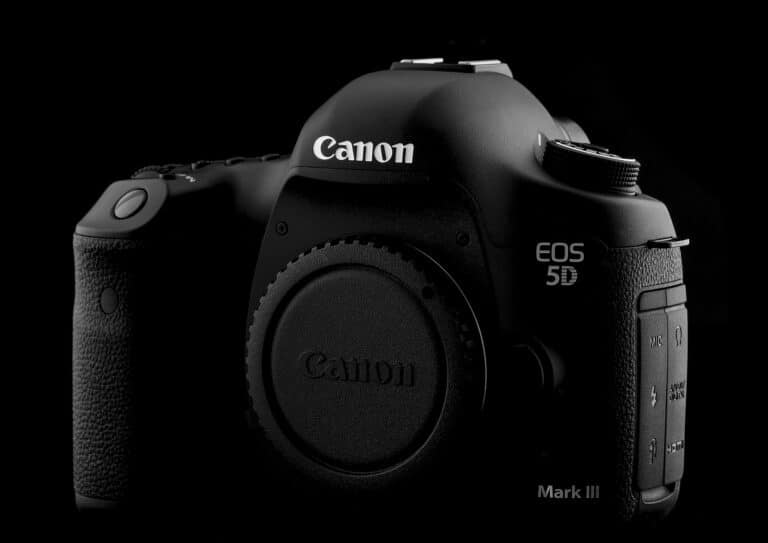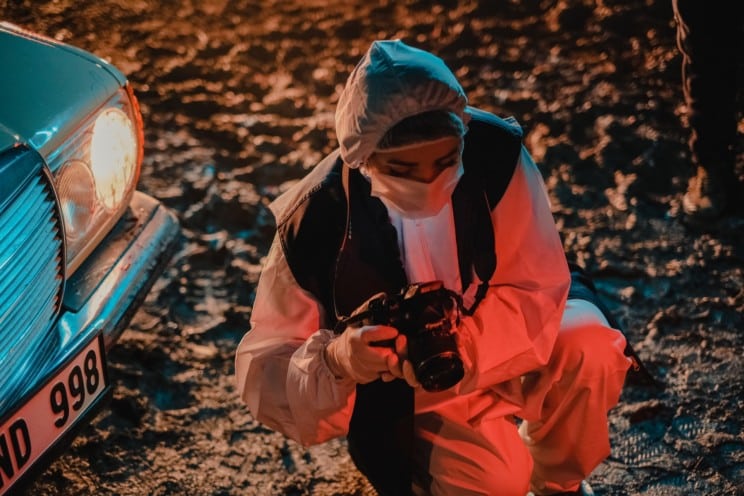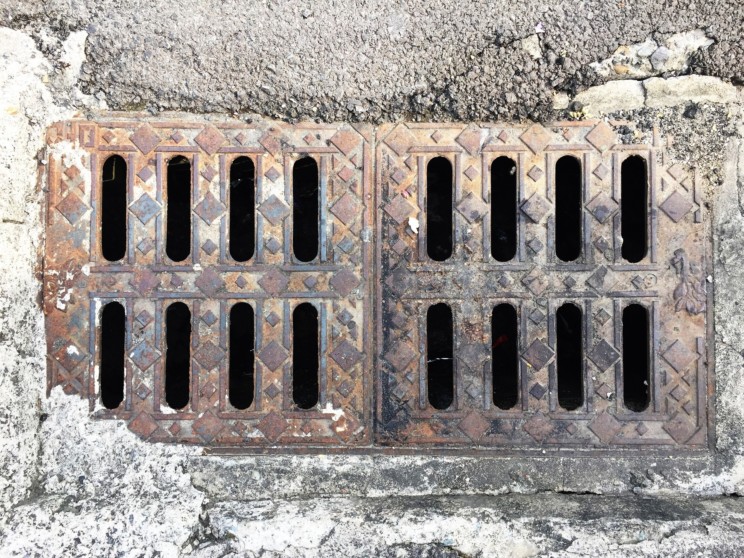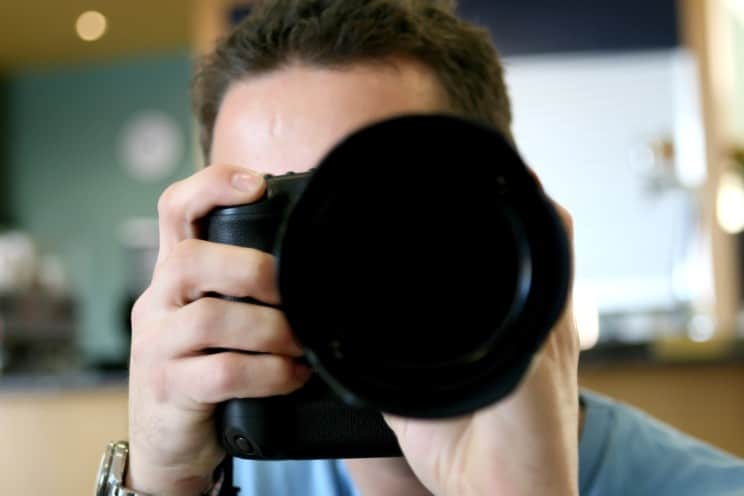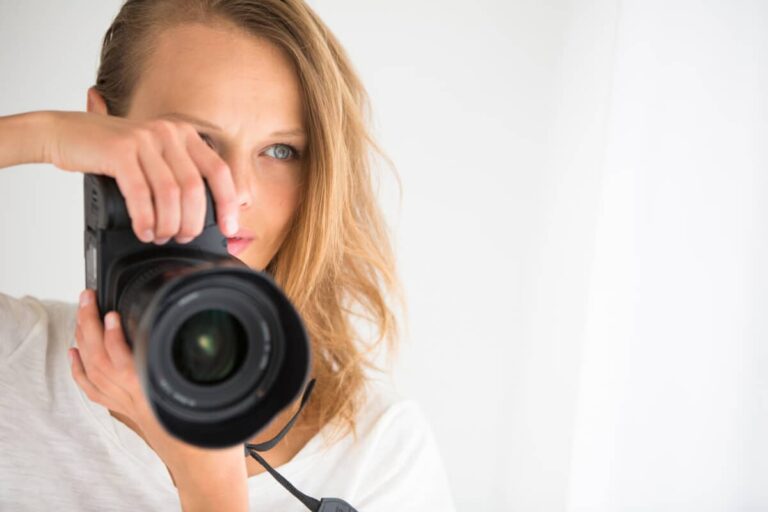Best Cameras for Photojournalism Reviewed
To become an award-winning photojournalist, you require two things: Your journalism skills and a high-quality camera.
To avoid getting confused, you need to understand the latest photojournalism camera technology and features which may require plenty of time.
In this article, we review the best camera for photojournalism that strikes the right balance between quality and price.
We’ll list each of the best photojournalism camera features and mention their essential features, pros, and cons.
Best Cameras for Photojournalism | Product Reviews
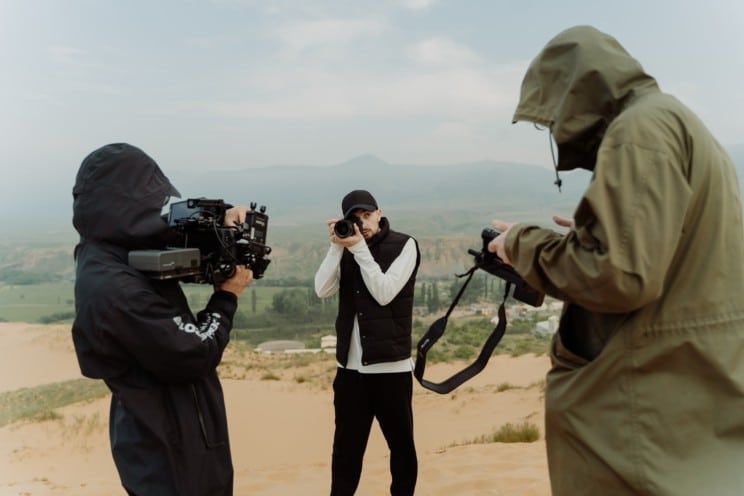
Sony a9 II
Sony has recently unveiled this excellent camera for photojournalism, which is fantastic.
This camera is a powerhouse in speed, image quality, autofocus, burst rate, tracking, and subject recognition.
The Sony a9 II is the first camera to have a full-frame stacked CMOS sensor with integrated memory in the world.
This gem can shoot photos at up to 20 frames per second constantly without blackout, making it perfect for photojournalism.
The camera is blackout-free; it has a completely silent electronic shutter putting it in a league of its own.
It gives you the advantage of shooting silently without anyone noticing or alerting the subject and the fulfillment of your decisive moment to shoot, not causing any disturbance.
Complete stealth!
Another benefit of this camera is its shutter speed which allows you to push two full stops faster, up to 1/32,000 sec.
Even in the sunniest conditions, you can shoot wide-open if you are a bokeh-loving, fast prime lens user.
The camera has a powerful battery that can last up to 480 shots with a viewfinder and around 650 images with an LCD monitor.
You can use Sony a9 II to record videos for up to 105 minutes with a viewfinder and 120 minutes with an LCD monitor.
Sony a9 II has an operating temperature of between 32 and 204 ℉ and 0 to 40 °C, which is impressive.
It comes in numerous accessories such as an accessory shoe cap, AC adaptor, eyepiece cup, power cord, and battery charger BC-QZ1.
Additionally, it comes with a micro USB cable, cable protector, body cap, and shoulder strap.
The camera coming with all these accessories saves you the struggle of purchasing them separately and for a few dollars.
Product highlights
- 5 GHz Wi-Fi, 1000BASE-T Ethernet
- Dual UHS-II SD Card Slots, Voice Memos
- 24.2MP Exmor RS CMOS Sensor
- Up to 20 fps Shooting, ISO 100-204800
- Blackout-Free Quad-VGA 3.7m-Dot OLED EVF
- 3 inches 1.44 meters Tilting Touchscreen LCD
- UHD 4K30p Video, Real-Time Eye AF
- 5-Axis SteadyShot INSIDE Stabilization
- BIONZ X Image Processor & Front-End LSI
- 693-Point Phase
Pros
- 4K video
- Blackout-free capture at 20fps
- Wireless and wired file transfer
- Superlative autofocus system
- Dust and splash protection
- 24MP full-frame sensor
- 5-axis IBIS
Cons
- The battery doesn’t match SLR rivals
- No S-Log video profiles included
- Can’t switch to video when clearing image buffer
Canon EOS R5
With the camera purchase rate reducing in the last few years, many brands are coming up with different ways of enticing customers.
Canon has a unique one; throw everything into the specification and watch customers start streaming in.
That’s generally the idea behind the EOS R5.
EOS R5 is mirrorless with every feature that a photojournalist requires.
It has a 45-megapixel full-frame sensor, and it can capture 4K and 8K video, making it an excellent option regardless of what you intend to shoot; portraits, sports, or weddings.
If you like shooting moving subjects at a pace, this camera is for you.
It has 12 frames per second burst mode which increases to 20fps if you use the electronic shutter version.
That is actually very quick which ensures that nothing will go amiss.
Canon EOS R5 has an excellent in-body stabilization system which is good for up to eight stops; this is a massive amount of anti-handshake assistance.
Product highlights
- 8K video quality and a raw video option
- 100% coverage Dual Pixel II AF system with human and animal detection trained by machine learning
- 5.76M-dot OLED EVF with 120 fps max refresh rate
- 12 fps / 20 fps bursts
- Fully articulating touchscreen
- 1x CFexpress slot slot
- 45MP full-frame Dual Pixel CMOS sensor
- 10-bit HDR photos in HEIF format
- Claimed weather-sealing to EOS 5D Mark IV levels
Pros
- Supreme autofocus modes – the tracking for humans/animals are impressive
- Super-detailed 45-megapixel images
- 12fps mechanical burst
- In-body image stabilization is excellent
Cons
- Easy to move focus point by accidental screen touch
- Overheats in high-end video modes, which limits in-camera record time
Canon EOS 5D Mark IV
Canon has continued its legacy of producing quality workhorse cameras with the release of the 5D Mark IV.
Let’s start with the 24-105mm f/4L II lens, making it a fantastic photography choice and 4K video gadget.
From the moment you pick this camera up, you’ll notice the satisfying hold it provides.
Canon’s engineers have reduced the 5D Mark IV weight by 60g compared to the previous release, Mark III.
The camera features a customizable button just below the joypad, which you can use to perform numerous functions with the front command dial.
For example, you can set it to control ISO and toggle the sensitivity without taking your eye away from the viewfinder.
Its AF system sensitivity is -3EV (-4EV in Live View), darker than moonlight. Therefore you can’t have challenges focusing in poor light with this camera.
This camera is perfect for wildlife photography and sports due to its teleconverter/lens combination with a maximum aperture of f/8.
The rear display has an impressive resolution, making it one of the sharpest screens in the photojournalism world.
It also makes composing shots easy and excellently straightforward, without noticeable signal noise.
The 5D Mark IV has headphone ports, external microphone ports, USB 3.0 terminals, and HDMI Mini which are essential for every photojournalist.
It also features both NFC connectivity and Wi-Fi, making it pretty easy to transfer images to a compatible device – and that’s not forgetting the built-in GPS unit for location-tagging.
Product highlights
- 36 x 24mm 30.4MP CMOS sensor
- LP-E6N rechargeable lithium-ion battery
- ISO range of 100-32,000
- Full frame focal length conversion
- Optical pentaprism with approx. 100% coverage
- Shutter speed of 30-1/8,000 sec plus Bulb
- 890g weight
- 4K video resolution at 30fps
- Max burst rate of 7fps
Pros
- Solid build and handling
- Dual Pixel CMOS AF for live view and video
- 30MP sensor making it way better than its 24MP rivals
Cons
- The 1.64x crop of the sensor makes it hard to get wide-angle shots
- Fixed rear screen
- Middle of the road resolution and frame rate
- Heavy 1.64x crop for 4K video
Nikon D5 DSLR
If you are a photojournalist who needs reliability, performance, and versatility in one camera, this is the gadget to purchase.
It has a five-image processor and an AE/AF of 12 fps, allowing you to have 200 stunning photos.
Additionally, it will enable you to record high-resolution 4K videos at 30fps.
Nikon D5 DSLR has an ISO range that you can extend to 3280000 ISO, giving you excellent low-light performance.
Therefore, regardless of your location; low light press conference room or a dark outdoor night, expect quality images with this camera.
Another thing that makes this camera stand out is its color fidelity feature that enhances the photo and video quality making it perfect for documentary photography.
Product highlights
- DSLR form factor
- CMOS Sensor 20.8MP FX-Format
- Time-lapse feature
- Auto white balance
- ISO 102400; can expand to 3280000
- 12 fps continuous 200 shoots
Pros
- Great low-light performance
- 4K Video And HDMI Output
- Convenient touchscreen monitor
- Faster continuous shooting
- 153-Point Autofocus System
- UHD video recording
- Better picture quality
- Extended ISO range
Cons
- No Wi-Fi or Bluetooth
Nikon D850 FX
If you want thrilling new capabilities to take excellent shots, Nikon D850 is perfect.
It has a speed of 9 fps which is relatively high but perfect for a photojournalist.
It has a superior AF system that gives it performance stability; hence you can consistently take masterful quality images.
With a resolution of 45.7 megapixels, this camera will give you excellent-quality videos and images for photojournalism.
This camera has slow-motion 1080p video recording at 120 frames per second speed.
This camera is pretty easy to use thanks to its tilting touchscreen and battery that lasts for long hours.
For extra photo sharpness when using this camera, have a Fisheye lens mounted.
Product highlights
- SLR form factor
- Full frame sensor
- Video resolution: 1080p
- Auto white balance
- ISO 64; expandable to 32
- Nine fps continuous shooting
- Max resolution: 47 MP
Pros
- Full frame sensor
- Good for journalists
- Greater dynamic range
- It comes with a flipping touchscreen
- Faster image processing
- Autofocus and white balance
- Vibrant image quality
Cons
- It might be a little bit pricey for beginners.
Fujifilm X-T3
Fujifilm’s new fantastic innovation, the X-T3 mirrorless digital camera, is just what you need to take your photojournalism career to the next level.
One spectacular aspect of this camera is its body, made of durable magnesium alloy.
Therefore, you can use it outdoors regardless of the weather conditions.
FUJIFILM X-T3 has a 30 fps continuous shooting speed, applicable when taking moving car photos or creating wildlife documentaries.
It has an X-processor CMOS 4 sensor, a back-illuminated sensor that improves image quality.
This feature allows excellent picture quality without an optical low-pass filter.
The camera has an ISO of 160, allowing you to take sharp images almost with zero effort.
Since its AF system can track subjects in motion, it has an ISO range of 12800, perfect for noise reduction.
The NR process helps to reduce it further through differential data.
Product highlights
- 4K video recording
- Mirrorless
- HDMI output
- Auto white balance
- X trans CMOS 4 (26.1MP)
- 11 fps continuous shooting
- Noise-reducing ISO 12800
Pros
- Interchangeable lens type
- Back-illuminated sensor
- Enhanced ISO performance
- Blackout-free continuous shooting
- Tilting touch screen panel
- Internal SD card for storage
- Better color depth
Cons
- A little bit pricey for beginners
Pentax K-1
You want to capture every moment and detail as a photojournalist, and Pentax K-1 allows you to do exactly that.
Your high-quality, low-light performance, precise AF system, superior white balance, and powerful image processor are what you need to stand out.
This camera is engineered using a highly effective full-frame CMOS sensor (36.4 MP); a feature that allows you to take excellent quality and high-resolution photojournalism pictures.
It has an ISO sensitivity range that you can expand up to 204800 for better noise reduction.
This improved processing capability lifts low-light performance to a satisfactory level.
The full-frame sensor also helps to resist noise at its best.
Regardless of your environment’s lighting conditions, trust its PRIME IV Processor to bring out stunning quality photos.
The Pentax K-1 is one of the easiest-to-use photojournalism cameras because its functionalities are not so complicated.
Additionally, its body is of excellent quality, allowing you to use it in the rigors of working in harsh weather conditions.
Product highlights
- SLR
- Wireless connectivity
- Cross tilt LCD
- Auto white balance
- 36.4MP CMOS Sensor
- Weight: 2.22 pounds
- LED-illuminated body points
Pros
- Weather-resistant construction
- Compact and balanced weight
- Convenient LCD screen
- Flexible Wi-Fi connectivity
- Enhanced ISO performance
- Daylight and cloud balance
- It has an excellent noise-reduction algorithm
Cons
- Video resolution is standard but not high.
Canon EOS R6
This camera’s expanded ISO and enhanced AF performance make it stand out in the photojournalism field.
It comes with two shutter options allowing you to shoot continuously at a faster rate.
It has a silent electronic shutter with about 20 frames per second, whereas the mechanical shutter shoots at 12 fps.
Canon EOS R6 has a potent DIGIC X image processor and an ISO range of 100 – 102400, which you can expand further to 204800.
It also has deep learning technology that quickly detects heads, eyes, bodies, or faces, making it easy to capture moving objects.
Canon EOS R6 has a 20MP full-frame sensor that makes it possible to capture high-quality images. You can cover almost 100% area with the dual pixel CMOS AF.
In addition, it has ultra-high-definition video recording capability at 2160p.
It has a tilting screen that allows you to capture images from all angles. Its buttons are well-made and feature an easy-to-use finger positioning while you’re shooting.
Product highlights
- Telephoto lenses
- Mirrorless
- 20 fps continuous shooting
- Auto white balance
- Cont. shooting: 12 fps (Mechanical Shutter)
- DIGIC X Image Processor
- Cont. shooting: 20 fps (Electronic Shutter)
- Full-frame CMOS (20MP)
Pros
- Incredibly faster shooting
- UHD quality video recording
- Expanded ISO range
- Better AF coverage
- Two shutter options
Cons
- It Lacks a Top LCD Screen
- Limited video recording options
Nikon D4s DSLR
With its image quality and specifically noise performance, Nikon D4s DSLR produces excellent results right up to ISO25600 and ISO51200, the highest ISO setting of any Digital SLR available.
The Nikon D4s DSLR has reliable exposure, detail, excellent color, low noise, incredible dynamic range, and highly continuous shooting and rapid focusing.
With this camera, you can shoot high-speed photos at 199 shots at 9.9fps without slowing down when shooting JPEG.
This speed makes it perfect for wildlife and sports photojournalism.
The body of this camera is awe-inspiring with a magnesium weather-sealed material.
This makes it an excellent value for money as it can withstand any weather condition hence lasting long.
Additionally, it has a two-year warranty; therefore, you can return it to your supplier in case of any issues.
Key features
- 16.2 megapixel FX Full Frame Sensor (Revamped)
- ISO10025600, expandable to ISO50-409,600
- 11fps continuous shooting with AF/AE
- 3.2inch 921k dot screen, improved color range
- Slow-motion 60/50fps in 720p
- Full HD Video, 60p, 50p, 30/25/24fps
- AF with tele-convertor up to f/8
- Uncompressed HDMI output
- Illuminated buttons, back, side, and top LCDs
- Gigabit 100/1000TX Ethernet – with FTP/HTTP support for instant uploads
- XQD and Compact Flash Slots
- IPTC can be added in-camera, GPS GP-1 compatible to update time from GPS signal
- Active D-Lighting, HDR, Picture Control, variety of retouch menus
- Kevlar/carbon fiber-composite shutter unit rated for 400,000 shots
- Spot White Balance metering
- Dual-axis electronic virtual horizon, also visible in the viewfinder
- Create time-lapse videos in the camera
- Updated AF system, 51 AF points, focus and take pictures in moonlight (-2EV)
Pros
- Auto shutter speed control for auto ISO (based on the lens)
- 11fps continuous shooting speed with AF/AE
- Improved battery life
- Excellent 3.2-inch screen
- Excellent weather-sealed build
- Excellent noise performance and expanded range
- Deep buffer
- 400,000 shot shutter rating
- Color adjustable monitor
- 60p and 50p video recording
- Two-year warranty
Cons
- Loud shutter
- It doesn’t include capture NX2
Camera For Photojournalism: Buying Guide
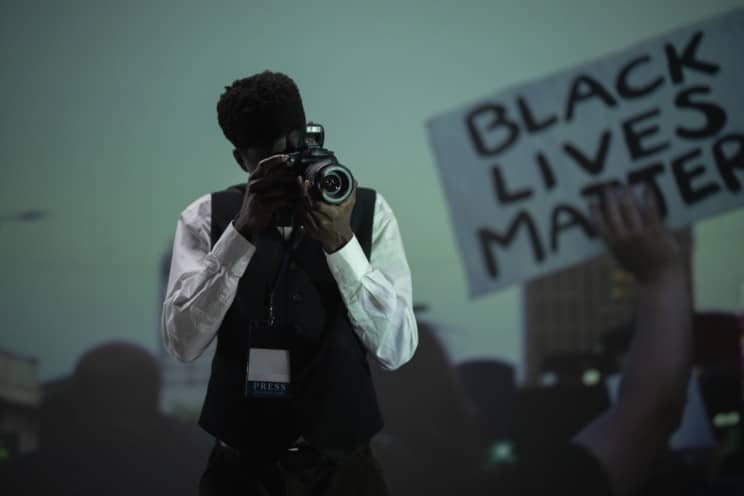
Buying a photojournalism camera is exciting, and you’ll naturally have a lot of emotions regarding the process.
However, choosing a camera that meets all your needs can be overwhelming, especially with thousands of choices available in the market.
A photojournalism camera is a long-term investment; therefore, you should take your time and decide on the one that will serve you best.
Below are some of the essential aspects you should consider when buying a photojournalism camera:
Image Sensors
In photojournalism, quality is everything and image sensors help you attain it.
They convert color and light spectrum into electrical signals then the camera converts them into ones and zeros enabling you to capture all excellent moments.
For photojournalism 35mm full-frame sensor is perfect if you want the highest-quality images.
Zooming Abilities
As a photojournalist, you may need to make videos and capture images from a distance.
Though some cameras may have fixed focal length lenses, which greatly enhance the quality of images, they are not enough for photojournalism.
Get a camera with a decent zoom ability of not less than 10x optical zoom, but 50x optical zoom would be much better.
If you plan to do professional wildlife photography, aim for the highest zoom ability as it requires a high degree of detail in taking images.
Ease Of Use
As a photojournalist, you will have projects that require you to be extremely fast in taking images.
At times, things will happen within seconds, and you need a camera that can capture those moments extremely fast.
Choose an easy-to-use camera so you don’t miss out on critical moments essential in elevating your career.
Size & Weight
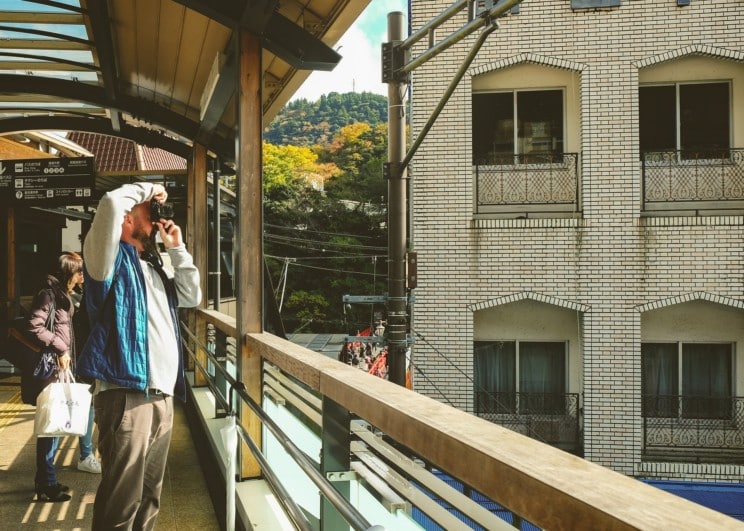
You carry your camera almost everywhere as a photojournalist, even in unexpected places.
Therefore a heavy camera with numerous lenses may not be proper for you.
It would be best if you got a camera that has a lightweight and compact size which you can easily carry everywhere.
Resistance
The world of photojournalism is very unpredictable; one time, you’ll find yourself shooting in the rain, another in snow or even wind or sun.
It’s therefore advisable to get a camera that can withstand all weather conditions. Get one that is water, heat, freeze, heat, and dust resistant to avoid getting frustrated.
Low-Light Performance
Though it may sound irrelevant, it’s essential to consider the low-light performance of a camera before investing in it.
As a photojournalist, you’ll shoot in low-light areas like conference halls.
If your camera doesn’t have excellent low-light performance, you will end up with low-quality images.
Before purchasing your camera, check its low-light performance with and without a flashlight.
The low-light performance of a camera is signified by its ISO; the higher the number, the less light you will need, and the better the quality of images and videos under low light.
Manual Control
Manual control is essential in photography as it allows you to control the aperture and shutter speed, allowing you to take great shots.
If you buy a mirrorless or DSLR camera, you don’t have to check for manual control as their system is relatively automatic.
However, if you choose to get a bridge or point-and-shoot camera, ensure that you check whether it has manual control.
Price

Before investing in a camera, consider the cost and ensure that it doesn’t exceed your budget.
Unlike what most people assume, an expensive camera doesn’t necessarily mean excellent quality.
At times, a camera may be costly but lack basic specs, which are critical in photojournalism.
Check its specs before buying your camera and compare it against your work and budget.
Resolution (megapixels)
Today, numerous cameras have high-megapixels of about 45 and even 80 and above. There are two advantages of these megapixels: cropping latitude and big prints.
With a 61 MP camera, you will produce gigantic prints with tons of detail, and you will also be able to crop in on your subject for a magnified view.
Though a camera with high megapixels may serve you well, it has drawbacks.
First, high megapixels typically reduce high-ISO capabilities leading to noisy, low-quality images in low light.
Additionally, high resolution means large file sizes; this causes your memory card to fill up quickly.
When it comes to megapixels, it’s important that you consider your priorities which depend on the shoots you are making.
If you require high resolution images, ensure that you have enough storage.
Durability
If you plan to shoot photos to take videos outdoors, you should buy a weather-sealed camera. Your camera will withstand rain, heat, and wind, making it last longer.
Speed
If you are a photojournalist who requires photography action – wildlife or sports- you need a camera with high continuous shooting speeds.
Look into cameras that feature complex tracking algorithms like an animal or human eye AF. Additionally, you can look into 10+ frames per second and 50+ frames buffer.
Photojournalism Camera Equipment
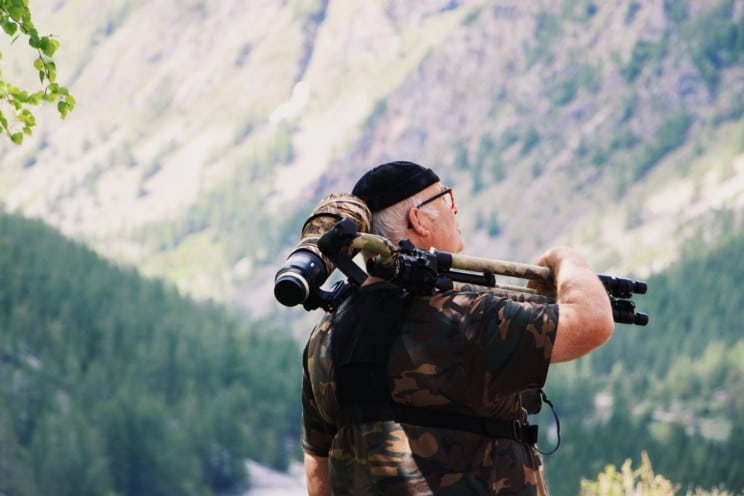
As a photojournalist, you ought to have a quality camera at the very least.
However, there are certain specifics that you should be part of your camera equipment kit if you want next-level photography. They include:
Lenses
Lenses are essential in creating stunning images as they ensure that the light reaches your camera sensor leading to quality images.
Regardless of the quality of your camera, the wrong lenses can lead to poor-quality photos and videos.
If your camera allows for interchangeable lenses, research the ranges of lenses available and choose based on the kind of shots you would like to take.
Wide-angle lenses will give you a more extensive field of view for Astro and landscapes and Astro.
Telephoto lenses allow you to zoom in on far-away subjects like athletes and birds.
Tripod
A tripod is especially critical if you’re interested in landscape photography or astrophotography.
When using a tripod, the camera stays still during exposures.
Using a tripod allows for lower ISO sensitivity and longer shutter speeds lowering sharp exposures and leading to minimal image noise.
A memory card
As a photojournalist, you’ll have a lot of data that needs storage and transfer to your computer; that’s where a memory card comes in handy.
Get a memory card that can hold plenty of photos — ideally over 1000 photos, if not more. Find a memory card of at least 16 GB, ideally, one that has 32 GB, 64 GB, or more.
A memory card is also essential in boosting your camera’s speed, which is critical in photojournalism.
Fast memory cards minimize your camera’s “buffering” time, helping you take more shots within a short time.
Cleaning kit
As a photojournalist, you want images of the highest quality.
It’s therefore essential to avoid minor smudges on your camera as they can distort details and get in the way of a photo’s overall quality.
To maintain your camera’s filters and lenses, get a cleaning kit with cleaning spray and a microfiber cloth.
Additionally, there are other alternatives, such as wet and dry cleaning products.
Final Thoughts
There you have it! Ten best cameras that you ought to invest in as a photojournalist.
Each of them is packed with photographic tech to help you take excellent images.
It’s important to note that the best photojournalism camera depends on what you intend to shoot.
If you are focusing on fashion or beauty, you want a camera with a high resolution so you can crop in and print images on a large scale.
If you are focusing on news and sports, consider the tracking capability, burst rate, and weather sealing of your camera.
If you’re a beginner in the photojournalism field, you may want to get something less intimidating, like an entry-level DSLR that can help guide you through camera filters and settings.
Alternatively, you can purchase one of the cameras discussed above.
After this, take the time to read the manual and reviews for excellent quality images which will take your photojournalism career to the next level.

